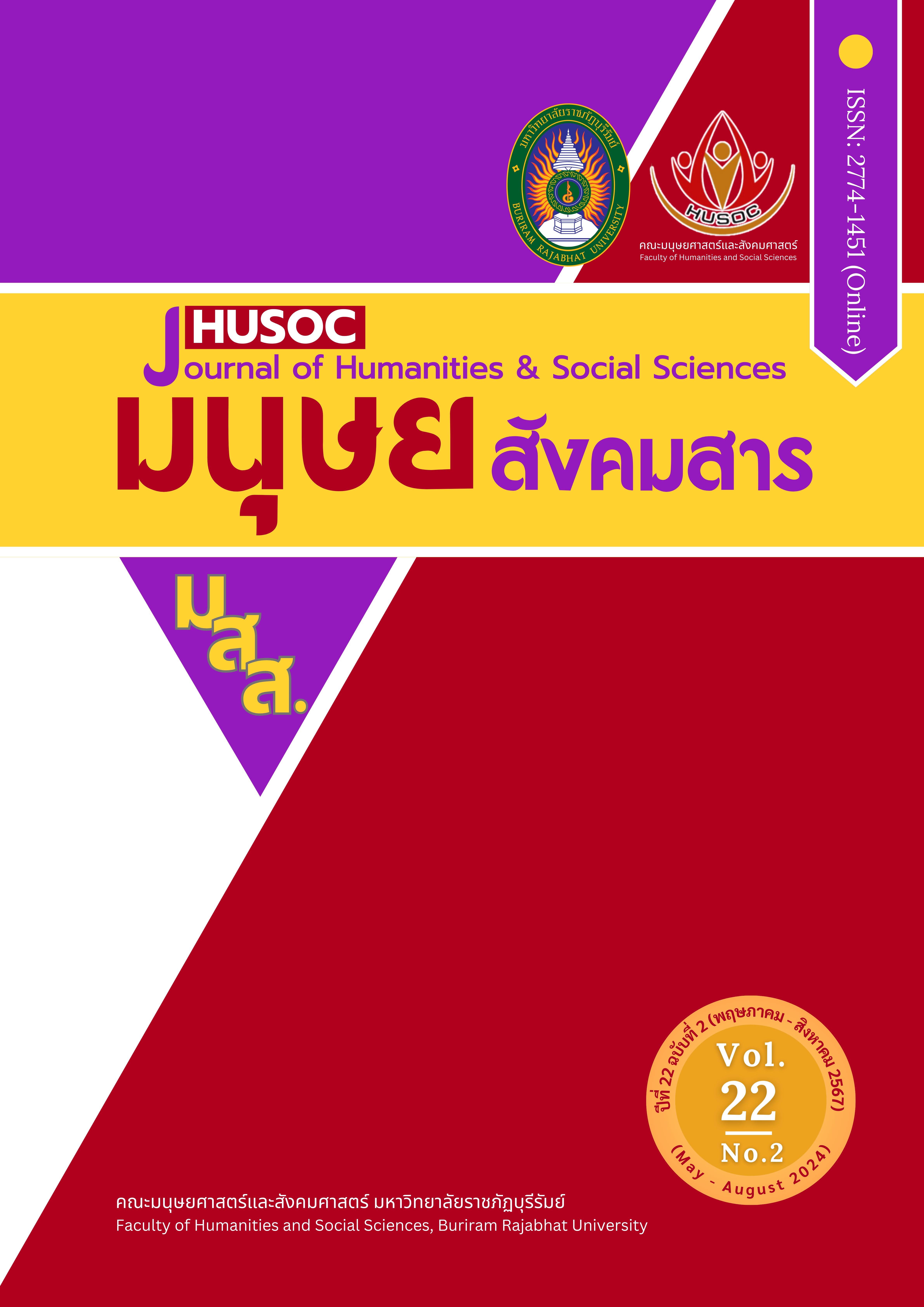อัตลักษณ์ร่วมของผ้าทอลุ่มน้ำโขงไทย-ลาว
Main Article Content
บทคัดย่อ
บทความวิจัยมีวัตถุประสงค์ 1) เพื่อวิเคราะห์อัตลักษณ์ร่วมของผ้าทอลุ่มน้ำโขงไทย-ลาว และ 2) เพื่อพัฒนาลวดลายผ้าทอจากอัตลักษณ์ร่วม โดยใช้แบบสัมภาษณ์เชิงลึก และอภิปรายกลุ่ม เลือกตัวอย่างแบบเจาะจงเป็นกลุ่มผู้ให้ข้อมูลสำคัญ จำนวน 30 คน นำเสนอผลการวิจัยด้วยการพรรณนาวิเคราะห์ ผลการวิจัย พบว่า 1) ชุมชนผ้าทอลุ่มน้ำโขงมีอัตลักษณ์ร่วมที่สำคัญ 3 ประการ คือ 1) อัตลักษณ์ด้านกระบวนการทอผ้าแบบเดิม ทั้งการสืบหูกและการค้นหูก การมัดหมี่ หมี่กาบและหมี่ลาย 3 ธรรมลำโขงเป็นลวดลายอัตลักษณ์ 2) อัตลักษณ์ด้านการใช้สีย้อมจากครามธรรมชาติ และ 3) อัตลักษณ์ด้านเรื่องเล่าของผ้าทอ เน้นเล่าเรื่องจากลวดลายจากความเชื่อดั้งเดิมและธรรมชาติ ได้แก่ ลายนาคขอ ลายนาคเครือ ลายกาบ ลายตุ้ม ลายหมากจับ 2) การพัฒนาลวดลายผ้าทอจากอัตลักษณ์ร่วม ได้แก่ (1) การพัฒนาองค์ความรู้ผู้ทอผ้าด้านการเตรียมเส้นใยและการย้อมสีเส้นใย (2) การพัฒนาเทคนิคการทอผ้าด้วยการใช้ฟืมขยายขนาด และ (3) การพัฒนาลวดลายผ้าทอด้วยการมัดหมี่
Article Details

อนุญาตภายใต้เงื่อนไข Creative Commons Attribution-NonCommercial 4.0 International License.
เนื้อหาและข้อมูลในบทความที่ลงตีพิมพ์ในวารสารทดสอบระบบ ThaiJo2 ถือเป็นข้อคิดเห็นและความรับผิดชอบของผู้เขียนบทความโดยตรงซึ่งกองบรรณาธิการวารสาร ไม่จำเป็นต้องเห็นด้วย หรือร่วมรับผิดชอบใดๆ
บทความ ข้อมูล เนื้อหา รูปภาพ ฯลฯ ที่ได้รับการตีพิมพ์ในวารสารทดสอบระบบ ThaiJo2 ถือเป็นลิขสิทธิ์ของวารสารทดสอบระบบ ThaiJo2 หากบุคคลหรือหน่วยงานใดต้องการนำทั้งหมดหรือส่วนหนึ่งส่วนใดไปเผยแพร่ต่อหรือเพื่อกระทำการใดๆ จะต้องได้รับอนุญาตเป็นลายลักอักษรจากวารสารทดสอบระบบ ThaiJo2 ก่อนเท่านั้น
เอกสารอ้างอิง
Chinachan, T. (2022). A product development of Long Li Jok textiles by using community’s cultural identities. College of Social Communication Innovation Journal, 10(1), 168-178. [in Thai]
Jungvimutiphan, K. (2010). The integration of cultural dimensions into the development of indigo-dyed cotton products by villagers of
Kanpalan village. Academic Journal of Architecture Khon Kaen University, 9, 61-68. [in Thai]
Leesuwan, W. (2016). Dictionary of fabrics and weaving textiles. Mueangboran Press. [in Thai]
Liewphairote, K., & Thammasthitdech, P. (2015). Action plan for promoting small and medium-sized enterprises in each sector of the textile industry. The Office of Small and Medium Enterprises Promotion (OSMEP). [in Thai]
Manarungwit, K. (2021). Symbol, beliefs, and the identity of Thai-Laos woven fabrics. Journal of Liberal Arts (Wang Nang Leng) RMUTP, 1(1), 55-75. [in Thai]
Namjaidee, S. (2022). An analysis of the as a role model in transferring knowledge on the wisdom of Pak Thong Chai silk, Nakhon Ratchasima Province. NRRU Community Research Journal, 16(1), 104-115. [in Thai]
Office of the Teachers’ Council of Thailand. (1963). Lancang historical annal Vol 2. Sueksaphanpanich Press. [in Thai]
Pholdee, O. (1994). Pattern of Tai cloth: The unique common heritage of the Tai ethnic group. In Committee promoting Thai style dress (Eds.), Pha Thai (30-57). Khurusapha Press. [in Thai]
Phra Ariyanuwatara Khemmajaree. (1970). PrayaKhamkong (Son Prai). Northeastern Folk Literature Conservation Centre. [in Thai]
Saithong, A. (2002). Indigo and indigo dyed products. Sakon Nakhon Rajabhat University. [in Thai]
Saithong, A. (2015). The pattern creation and the dyeing process of indigo fabric of Phu Tai people in Thailand, Laos and Vietnam. Institute of Culture and Arts Journal, 17(1), 130-137. [in Thai]
Sawasdee, Y. (2018). Study and development of fabric construction motif for create new identity of Thai silk. A Thesis Submitted in Partial Fulfillment of Requirements for Master of Fine Arts (fine arts). Faculty of Fine Arts, Srinakharinwirot University. [in Thai]
Smutkupt, S., & Kitiasa, P. (1994). Ways of Isan weavers: Development of textile production and the changing roles of women in contemporary Isan villages. Somboon Press. [in Thai]
Tangtavonsirikun, C. (1998). Symbolism of Laos textiles. The Foundation for the Promotion of Social Sciences Textbooks Projects. [in Thai]
The Queen Sirikit Museum of Textiles. (2017). How to take care of your textiles. The Queen Sirikit Museum of Textiles Conservation Division. [in Thai]
The Research Institute of Northeastern Arts and Culture. (2019). A guide to learning about woven textile. Mahasarakham University. [in Thai]
Udomsup, V. (2000). Using natural dyes from plants to dye fabric. Journal of the Faculty of Architecture King Mongkut’s Institute of Technology Ladkrabang, 2(1), 73-82. [in Thai]
Wannamas, S. (1991). Thai textiles with Isan motive. Odeonstore Press. [in Thai]


